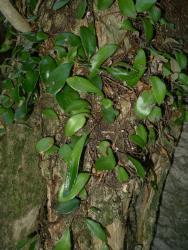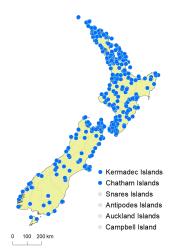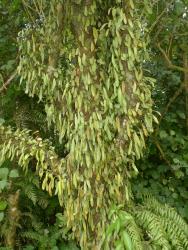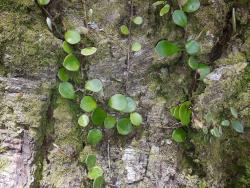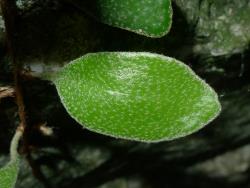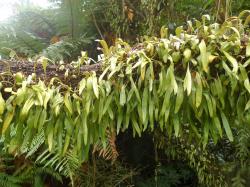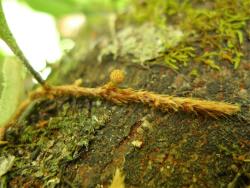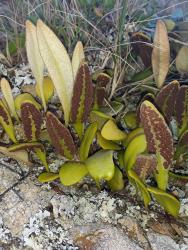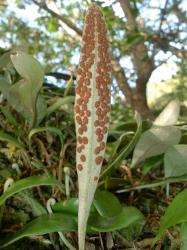- Taxon
- Gallery
- ≡ Polypodium eleagnifolium Bory in Duperrey, Voy. Monde, Crypt. 259, t. 31, f. 1 (1829) – as eleagnifolium
- = Polypodium rupestre var. sinuatum Colenso, Trans. & Proc. New Zealand Inst. 17: 257 (1885)
Epiphytic and terrestrial, creeping and climbing ferns. Rhizomes long-creeping, 0.75–2 mm diameter, densely scaly. Rhizome scales peltate, narrowly ovate, 2–7 mm long, 0.5–1 mm wide, squarrose, orange-brown; margins entire or sometimes denticulate. Stipes winged for much of their length and indistinct from the attenuate lamina base. Fronds undivided, very varied in shape; sterile fronds almost orbicular to elliptic, obovate or spathulate, 20–185 mm long (including stipe), 11–31 mm wide; fertile fronds narrowly obovate to spathulate or sometimes narrowly elliptic to narrowly oblong, 30–260 mm long (including stipe), 4–20 mm wide; apex obtuse to rounded, margins entire, base attenuate to an indistinct stipe; dark green, coriaceous to succulent; scattered stellate hairs on adaxial surface, densely covered in fawn or rarely silver-coloured stellate hairs on abaxial surface. Veins obscure, hydathodes absent. Sori round or slightly elongate, 2–4 mm long, superficial or partly impressed into the lamina, not or rarely protuberant on adaxial surface, irregularly arranged in 2–5 rows either side of midrib, rarely almost confluent with age, occasionally confined to distal part of lamina, paraphyses present as stellate hairs, exindusiate.
Pyrrosia elaeagnifolia is the only species of the genus present on the main islands of New Zealand, and is easily distinguished by its long-creeping rhizome; thick, fleshy, undivided fronds; dense covering of stellate hairs; and exindusiate sori arranged in several rows either side of the midrib.
Pyrrosia elaeagnifolia and P. serpens have both been recorded from the Kermadec Islands and characters for distinguishing the two are listed under the latter species.
Very occasional aberrant fronds are found with lobed or bifid fronds, and sometimes the rhizome apices are fastigiately divided into multiple growing tips. The latter has been attributed to a gall-forming mite, Aceria sp. (Hovenkamp 1986, p. 178).
North Island: Northland, Auckland, Volcanic Plateau, Gisborne, Taranaki, Southern North Island.
South Island: Western Nelson, Sounds-Nelson, Marlborough, Westland, Canterbury, Otago, Southland, Fiordland.
Kermadec Islands, Three Kings Islands, Chatham Islands, Stewart Island.
Altitudinal range: 0–860 m.
Pyrrosia elaeagnifolia occurs on the Kermadec and Three Kings Islands, and is common in lowland to montane areas throughout the North Island, from Te Paki to Wellington. It grows from sea level, reaching 860 m at Huka Falls, near Taupō. It is found in lowland and montane areas throughout the South Island, but is uncommon in inland parts of Otago and south Canterbury. It grows up to 825 m on Mt Furneaux in the Marlborough Sounds and near Mt Cook. It extends to Stewart Island and the Chatham Islands.
Hovenkamp cited one specimen in U from Norfolk Island (A. Cunningham 33), but Green (1994) asserted that only one species, P. confluens, was present on the island. P. elaeagnifolia is treated here as endemic to New Zealand.
Pyrrosia elaeagnifolia is a very tough and adaptable fern, which can survive dry conditions due to its fleshy frond, dense covering of hairs and reduced lamina area. It occurs on rocks, logs, scoria and banks, and as an epiphyte on branches and trunks of native, naturalised and cultivated trees. It is found from exposed coastal situations to sheltered forest, in a wide range of scrub, beech, podocarp and broadleaved forest types.
n = 37 (Brownlie 1961, as Pyrrosia serpens).
New Zealand plants were previously referred to P. serpens (G.Forst.) Ching, but that species has ciliate rhizome scales, whereas those in P. elaeagnifolia are more or less entire (Hovenkamp 1986; Brownsey et al. 2021). The confusion arose because Forster identified New Zealand as the type locality for P. serpens, but his specimen is not conspecific with the species on the main islands of New Zealand. It was probably collected on one of the Pacific islands, and the specimen mislabelled (Hovenkamp 1986). P. serpens occurs across the Pacific from the Kermadec Islands and Fiji to Pitcairn Island.
Pyrrosia elaeagnifolia has been widely misidentified in earlier New Zealand literature under the names Polypodium stellatum Vahl, Polypodium serpens G.Forst., Niphobolus bicolor Kaulf., and Polypodium rupestre R.Br., and combinations based on them.
Cameron (2017) argued that, based on the original spelling of Elaeagnus latifolia L., the name “eleagnifolia” is an orthographic error that should be corrected to “elaeagnifolia”. That spelling is adopted here.



